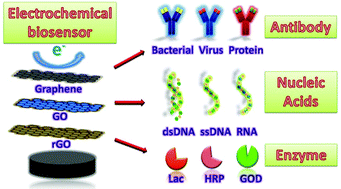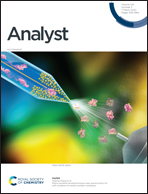Electrochemical biosensors based on antibody, nucleic acid and enzyme functionalized graphene for the detection of disease-related biomolecules
Abstract
The unique physical structure and chemical and electrical properties of graphene make it an ideal choice for sensor materials. The sensing platform of biomolecule functionalized graphene has received extensive attention due to its high sensitivity and selectivity, especially the biosensors constructed by combining antibodies, nucleic acids and enzymes that efficiently recognize specific targets with graphene having a large specific surface area and a fast electron transfer rate, which has become a significant research direction. In this paper, electrochemical biosensors based on graphene materials developed in recent years are summarized. The methods of functional modification of graphene, graphene oxide and reduced graphene oxide with antibodies, nucleic acids and enzymes are briefly described. In addition, the advantages and disadvantages of the constructed electrochemical biosensors in detecting pathogens and disease markers are also reviewed. Finally, we are optimistic about this prospect for the development direction and application prospects of such electrochemical biosensors.



 Please wait while we load your content...
Please wait while we load your content...